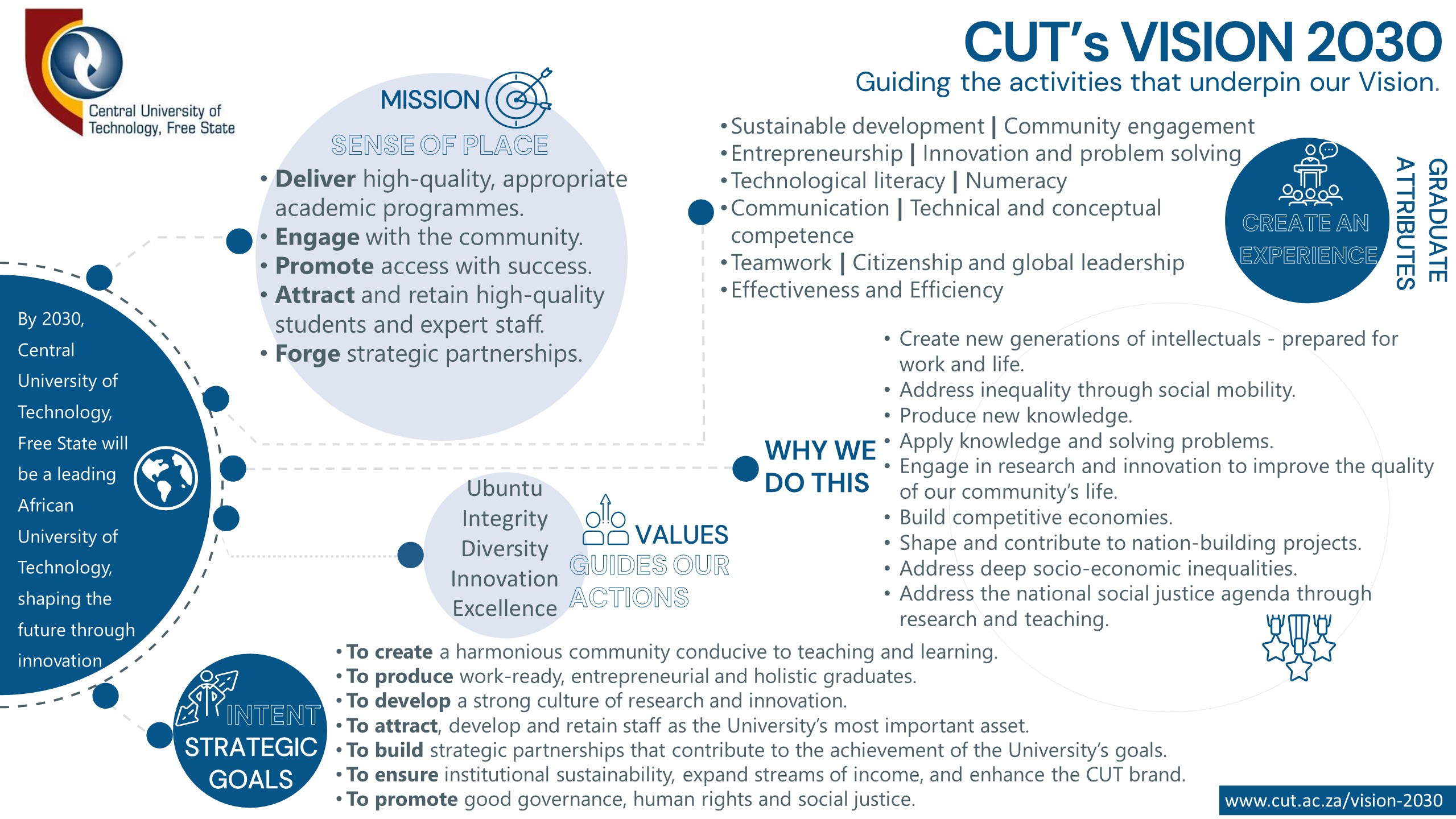Download the updated Vision 2030 Infographic PDF , JPG | 01 March 2023
Vision 2030 document
This is a living document and changes may occur.
CUT Vision 2030 (PDF) | 28 October 2020
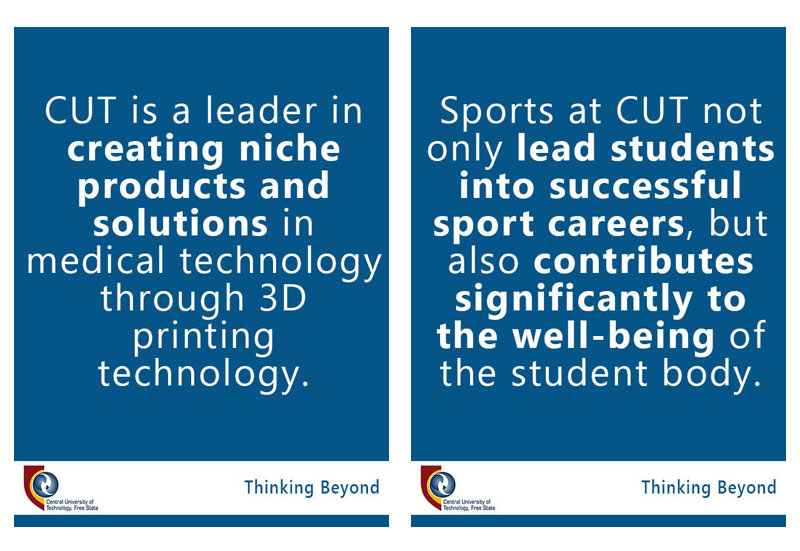
Brief introduction to CUT's Vision 2030
The mandate of a University of Technology in South Africa is essentially to create skillful and responsible citizens.
The National Development Plan 2030 (NDP) notes that Higher Education is “the major driver of information and knowledge systems that contribute to economic development”. But it is “also important for good citizenship and for enriching and diversifying people’s lives” (NPC 2012:317).
The White Paper for Post-School Education and Training states that all universities are expected to have a clearly defined mandate within the system; to offer high-quality undergraduate education; to engage in “some level and type of research”; to address the imperatives of equity and social justice; and to interface with TVET and other vocational colleges, SETAs, employers, labour and other stakeholders (DHET 2013:30).
At a CUT planning Lekgotla in March 2020, the Vice-Chancellor, Professor Henk de Jager, reminded the meeting of the following purposes of a University:
- Creating new generations of intellectuals.
- Addressing inequality through social mobility.
- Producing new knowledge about humanity and the universe.
- Applying knowledge and solving problems.
- Seeing the city or community as a site of engagement and bringing research and innovation to bear on improving the quality of life in the city, region, province, country.
- Building competitive local and national economies.
- Shaping and contributing to nation-building projects.
- Addressing deep socio-economic inequalities.
- Addressing the national social justice agenda through research and teaching.
Download the Sesotho (PDF) or Afrikaans (PDF) versions of the Vision, Strategic Goals, Mission, Core Values and Motto
Vision 2030 Statement
By 2030, Central University of Technology, Free State will be a leading African university of technology, shaping the future through innovation.
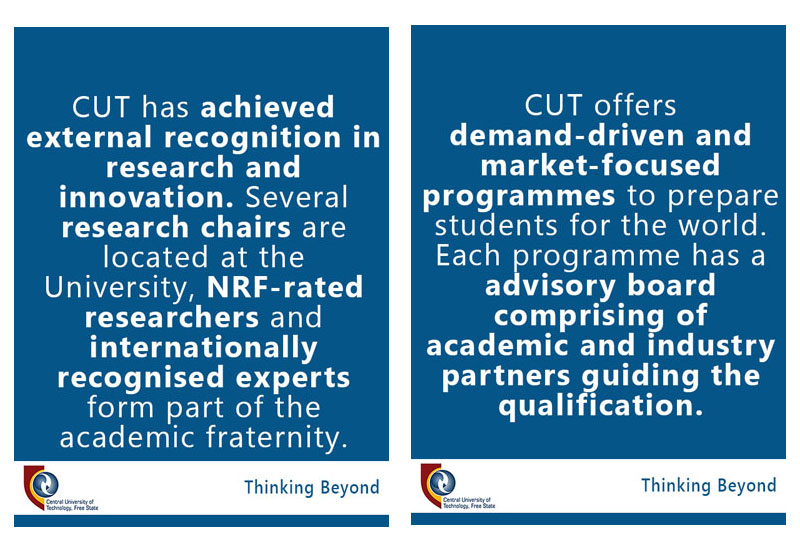
The notion of CUT as a leading African University of Technology should be seen against the background of the University’s aspiration to be socially relevant and to have a positive impact on the socio-economic conditions of the community it serves.
To be a leading African UoT is to recognise the location of the University geographically but also, more importantly, to recognise its location within the matrix of social and economic challenges that the continent faces. It talks to indigenous knowledge, a de-colonised curriculum, and distinctively African values such as ubuntu.
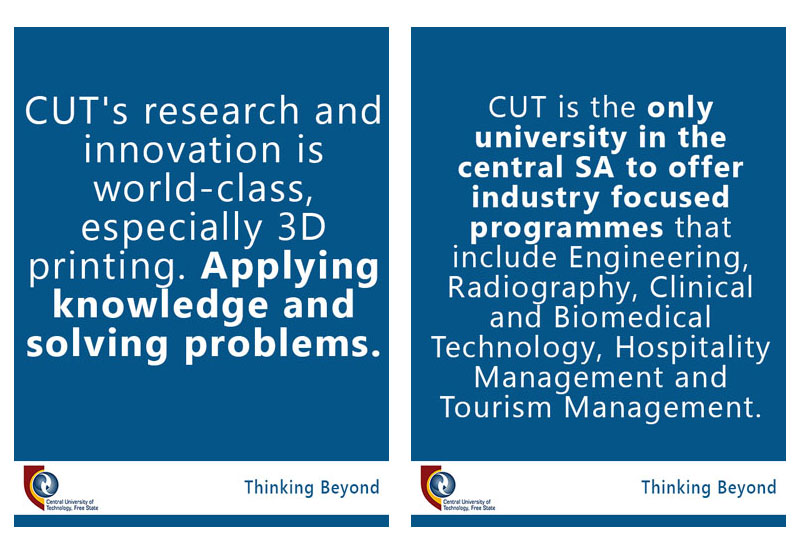
The future orientation of the vision statement – by 2030 – requires the University to project itself 10 years into the future, in an uncertain and rapidly changing world.
“Shaping the future through innovation” speaks to CUT’s aspiration to be an active force for change, finding novel and innovative solutions to the problems that the country and the continent face.
The vision statement is underpinned by seven strategic objectives arising from the stakeholder engagements and by the University’s mission statement, values, motto, and graduate attributes.
Strategic Goals
- To create a harmonious community conducive to teaching and learning.
- To produce work-ready, entrepreneurial and holistic graduates.
- To develop a strong culture of research and innovation.
- To attract, develop and retain staff as the university’s most important asset.
- To build strategic partnerships that contribute to the achievement of the university’s goals.
- To ensure institutional sustainability, expand streams of income, and enhance the CUT brand.
- To promote good governance, human rights and social justice.
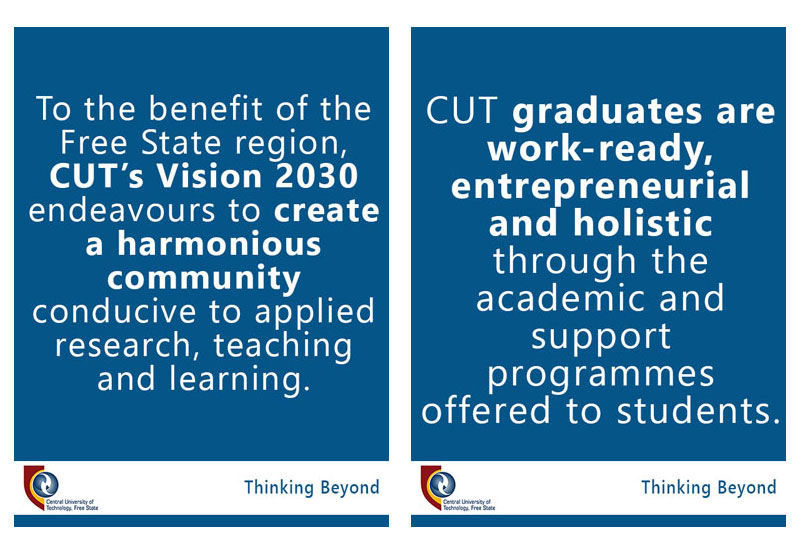
Mission Statement
In aspiring to fulfil its vision, the reimagined CUT, as a university of technology:
- delivers high-quality, appropriate science, technology, engineering and mathematics (STEM) academic programmes, as well as those in management sciences, education and humanities, supported by applied research;
- engages with the community for mutually beneficial development;
- promotes access with success in attracting potentially successful students, and supporting them to become employable and job-creating graduates;
- attracts and retains high-quality students and expert staff, and supports their development and well-being; and
- forges strategic partnerships that are mutually beneficial.
Core Values
The core values of the University are:
Ubuntu
Ubuntu is a distinctively African ethic of interdependence. It is captured in the phrase “umuntu ngumuntu ngabuntu” – a person is a person through other people. The quality of ubuntu includes humanity, compassion, mutual respect, and tolerance. Within the CUT context, we purposefully aim to create and sustain an environment that encourages and supports staff and students, enabling them to reach their full potential. This will be reflected in the way that we teach, learn, research, and engage with our communities, as well as students, staff, alumni and partners. CUT will nourish the commitment to provide excellent service by maintaining strong, supportive relationships that are flexible and responsive to the institutional and student needs and to the interests of society at large.
Important questions to be asked: Do I always place the people I serve first? Do I demonstrate that I am able to empathise with others and put myself in their shoes?
Integrity
As a campus community, we expect all conduct to be rooted in integrity, mutual respect and civility. We value ethical behaviour in scholarly and other endeavours. Integrity in our context will include the creation of a diverse, collegial scholarly community in which individuals are valued and respected, academic freedom is exercised with intellectual rigour, and high ethical standards and an environment where critical inquiry is encouraged are upheld. As our conduct should be rooted in integrity, mutual respect and civility, one can argue that trust and stewardship are integrated in this value. At the same time, accreditation processes that establish integrity as central to educational and institutional quality will be embraced within CUT. These will be benchmarked against trends in Higher Education in South Africa and Africa, as well as internationally. Therefore, we behave in an ethical and professional manner; we conduct our activities in an accountable and transparent manner; and we ensure the integrity of our information, systems and processes.
Important questions to be asked: Do I practice what I preach? Am I ethical and professional? Do I always uphold conduct that is informed by respect, honesty and dignity?
Diversity
Diversity has several dimensions and these dimensions fall into two primary categories: Social diversity and intellectual diversity. Social diversity means that the composition of our students, as well as our staff, must reflect broad societal characteristics that encompass race, class, multilingualism, ethnicity, national origin, religion, freedom of conscience, gender, sexual orientation, age and ability. Included in this perspective is the fact that CUT must have no discriminatory practices that will prevent it from bringing together, into one CUT, all the mentioned varieties and differences of society. If CUT thus coexists as a microcosm of the larger society in which we live, we will be able to classify ourselves as a diverse institution.
Intellectual diversity refers to the broad range of academic programmes, the variety of delivery modes we utilise, a diversity of theoretical approaches, and a broad definition of community service. Central to this value is openness and the continuance of the technology-driven tradition of CUT. Furthermore, fairness, honesty and objectivity will prevail as CUT assesses its own policies, practices and behaviours to ensure that it makes credible the actions taken to enhance quality improvement in higher education.
Therefore, we reflect and serve diverse regional, national and global communities; we promote an open society where critical scholarship and the expression of a multiplicity of opinions and experiences are actively encouraged; we foster an environment in which diversity is appreciated, respected and celebrated; and we are committed to accessibility, inclusivity and social justice. We embrace diversity in all its forms and complexity, appreciating the richness and dynamism it brings to the academic project and broader university life. We should ensure that the institutional culture is welcoming, supportive and inclusive, not alienating. Finally, we need to be conscious of the social injustices and unfairness of the past, as we commit to restore the dignity of every human being at CUT and beyond.
Important questions to be asked: Do I have an understanding regarding the definition of diversity in my context? Have I created an environment to support diversity?
Innovation
We are committed to innovative approaches for achieving our vision and will create a campus environment that encourages and rewards creativity and innovation. The aim is to empower students and staff to trust their creativity and skills to change the world; to motivate them to build the courage and excitement to stretch beyond their limits in technology, finding new ways of practice and design, thereby contributing to social and technological innovation; and to approach each day with a mindset ready to achieve greater heights, change and improve, and contribute to advancements in technology and life.
Important questions to be asked: Is this the best way/method/process/product? Have I thought about doing it differently? How creative am I? Do I always think of new ideas and approaches to doing things? Have I challenged the status quo?
Excellence
CUT aspires to an excellence that is approached through diligent effort, both individual and collective. Pursuing excellence means being satisfied with nothing less than the highest goals it is possible to envision. We value excellence and innovation inside the classroom and out. Thus, we strive to offer outstanding academic programmes; to foster intellectual inquiry, exploration, and 29 discovery; to transcend traditional boundaries; to apply and perfect knowledge; to encourage creativity; to provide effective tools, technologies and facilities for learning; and to excel in research and scholarly activity, including the “scholarship of teaching and learning” – an area of research that explores how individuals teach and learn.
We recognise and accept the sacrifices, risks and responsibilities involved in pursuing excellence, and so we celebrate one another’s successes. We commit ourselves to this process in an ethical and moral manner. Therefore, we promote, recognise and reward excellence in our teaching, learning, research, engagement and support services; we promote, recognise and reward excellent service delivery to all our stakeholders; we provide a supportive and affirming environment that enables students and staff to reach their full potential; and we adopt innovative approaches to promote excellence in our institutional policies, structures, processes and systems.
Important questions to be asked: Do I continuously strive to improve on previous efforts? Was this my best effort? Do I strive for excellence at all times and in all that I do?
Motto
The motto of CUT is Thinking beyond.
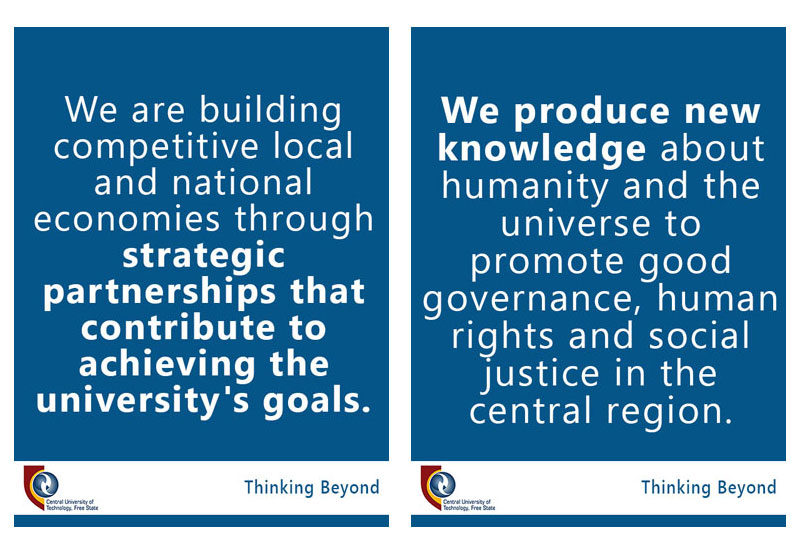
Graduate Attributes
CUT has identified 10 graduates attributes that it strives to inculcate in its graduates. Realising the attributes requires the alignment of activities in teaching and learning, curriculum renewal, assessment tasks and outcomes, as well as extra-curricular and sporting activities.
The attributes are:
- Sustainable development
- Community engagement
- Entrepreneurship
- Innovation and problem solving
- Technological literacy
- Numeracy
- Communication
- Technical and conceptual competence
- Teamwork
- Citizenship and global leadership

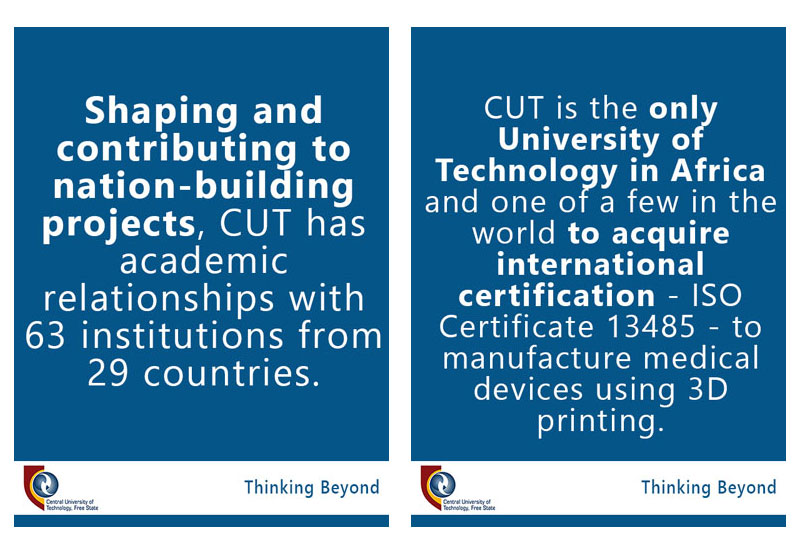
Annual Performance Plan 2025
Institutional Planning and Quality Enhancement (IPQE)
Annual Performance Plan 2025 (PDF)
What is a University of Technology?
The story behind the design: Our Symbol
Archive: Vision 2020
